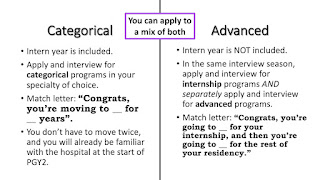Title: The Ultimate Guide to Categorical and Preliminary Residency Positions in USMLE
Keywords: USMLE, categorical, preliminary, residency positions, medical training, medical students, career goals, level of training
Are you a medical student preparing to apply for residency positions? If so, you'll need to understand the difference between categorical and preliminary positions in the USMLE. In this ultimate guide, we'll walk you through everything you need to know about these types of residency positions, from their definitions to their application processes.
First, let's start with the basics. A residency is a period of supervised medical training that follows medical school. Residency programs provide hands-on experience in a particular area of medicine and typically last between three and seven years, depending on the specialty.
When applying for residency positions, medical students can choose to apply for either categorical or preliminary positions. Categorical positions are designed for medical students who have completed medical school and are seeking a full residency program. These positions are typically longer in duration and provide a comprehensive education in a particular specialty.
On the other hand, preliminary positions are designed for medical students who have not yet completed a required preliminary year of training. These positions are typically shorter in duration and are meant to provide foundational knowledge and experience in a particular specialty.
So how do you determine which type of residency position is right for you? It all depends on your career goals and level of training. If you have completed medical school and are seeking a full residency program, a categorical position may be the best fit for you. However, if you have not yet completed a preliminary year of training, a preliminary position may be a better fit.
When it comes to applying for residency positions, the process can be competitive and complex. It's important to understand the application requirements and deadlines for each program you're interested in. You'll need to submit your application through the Electronic Residency Application Service (ERAS), which is a centralized application service used by most residency programs in the US.
In addition to submitting your application through ERAS, you'll also need to take the USMLE exams. The USMLE is a three-step exam series that assesses your knowledge and skills in various areas of medicine. The exams are a critical component of the residency application process and are used by residency programs to evaluate your candidacy.
So, what are some tips for preparing for the USMLE exams and the residency application process? Here are a few key things to keep in mind:
1. Start early: The residency application process can be lengthy and complex, so it's important to start early and give yourself plenty of time to prepare.
2. Know your strengths and weaknesses: Focus your study efforts on areas where you may need more practice or knowledge.
3. Seek out resources: There are many resources available to help you prepare for the USMLE exams, including study guides, practice exams, and review courses.
4. Network: Connect with other medical students and professionals in your field to learn more about residency programs and get advice on the application process.
In conclusion, understanding the difference between categorical and preliminary residency positions is crucial for medical students who are preparing to apply for residency programs in the US. By knowing your career goals and level of training, and by preparing thoroughly for the USMLE exams and residency application process, you can increase your chances of securing the residency position that's right for you.

